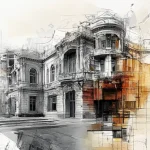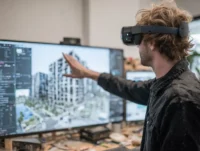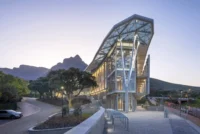In a world where technology constantly pushes the boundaries of what’s possible, parametric architecture stands out as a groundbreaking approach to design. By leveraging formal algorithms, we can create structures that are not only visually stunning but also functionally optimized. This innovative method allows architects to explore forms and patterns that were previously unimaginable.
Parametric design isn’t just about aesthetics; it’s about efficiency and sustainability too. Algorithms help us analyze countless variables, from material properties to environmental impacts, ensuring that every aspect of a building is fine-tuned for performance. As we delve into the realm of parametric architecture, we’ll uncover how these sophisticated tools are revolutionizing the way we think about and create our built environment.
The Essence Of Parametric Architecture
Parametric architecture centers on the use of algorithms to dictate design parameters. These algorithms consider numerous factors, including spatial constraints, environmental considerations, and material properties, to generate optimized forms. The essence lies in how these variables interconnect and influence the design outcome.
One of the critical aspects of parametric design is its adaptability. Designers manipulate parameters to explore various outcomes, making it possible to create custom solutions for specific site conditions or client needs. For example, altering the algorithm’s input can change a building’s facade, improving its energy efficiency or aesthetic appeal.
Visualization plays a crucial role in parametric architecture. Advanced software tools enable us to model complex shapes and structures that would be challenging to conceive using traditional methods. By visualizing these models, architects can better understand the implications of their designs and make informed decisions.
Integration with sustainability is another core element. Parametric algorithms can optimize building performance by analyzing factors like daylight availability, thermal comfort, and energy usage. For instance, a parametric model might configure window placements to maximize natural light while minimizing heat gain, thereby enhancing both comfort and energy efficiency.
Parametric architecture also fosters collaboration. Different stakeholders, including engineers and urban planners, can input variable data into the same model, ensuring all aspects of the design align with practical and regulatory requirements. This holistic approach improves overall project cohesion and outcome quality.
The transformative nature of parametric architecture reshapes our built environment. By leveraging formal algorithms, we push design boundaries, creating innovative, functional, and sustainable structures. These advancements are redefining conventional architectural practices, emphasizing flexibility, precision, and performance.

Historical Context
Parametric architecture’s origins are deeply rooted in the evolution of computational design, dating back several decades. The notion of using algorithms to shape architectural forms has undergone significant developments, transforming from theoretical concepts into practical applications.
Early Developments
In the 1960s, architects first experimented with computer-aided design (CAD). Ivan Sutherland’s Sketchpad, a pioneering CAD system, enabled users to create geometric shapes graphically. Throughout the 1970s and 1980s, architectural practices began adopting CAD systems, integrating computational methods into mainstream design processes. Pioneers like Nicholas Negroponte and Craig Reynolds explored design rules and algorithms, laying the groundwork for parametric concepts.
Technological Advances
The 1990s marked a period of rapid technological enhancement, leading to advanced parametric modeling software. Tools like Rhino and Grasshopper facilitated complex form generation through parametric algorithms. The advent of Building Information Modeling (BIM) further bolstered parametric design’s capabilities, allowing architects to create data-rich models that respond to various parameters. These technological strides have enabled designers to push the boundaries of form and function, ensuring that parametric architecture continues to evolve and innovate in the present day.
Core Principles Of Parametric Design
Parametric design relies on certain principles to shape structures efficiently and creatively. It combines algorithmic logic with practical materials to produce optimized forms.
Algorithmic Foundations
Parametric architecture uses algorithms to automate and refine the design process. By setting rules and parameters, we can manipulate variables to generate complex shapes. These algorithms help us explore countless design options quickly, adjusting to spatial, functional, or aesthetic needs. For instance, algorithms can optimize the layout of a building to enhance natural light and improve energy efficiency.
Material Considerations
Materials play a crucial role in parametric design. By understanding material properties, we can craft structures that balance aesthetics and functionality. For example, tensile fabrics can create lightweight, flexible structures, while concrete can form intricate patterns with the help of digital fabrication techniques. Analyzing material behavior under different conditions, like stress or temperature changes, allows us to create more resilient and sustainable designs.

Notable Examples In Modern Architecture
Parametric architecture has led to the creation of remarkable structures worldwide. Leveraging algorithms to shape design, architects are redefining the built environment. Here, we explore some iconic structures and emerging projects showcasing this innovative approach.
Iconic Structures
The Guggenheim Museum, Bilbao
Frank Gehry’s Guggenheim Museum in Bilbao represents a pioneering use of parametric design. Utilizing digital modeling, the complex, undulating forms were created to reflect the interplay between the building and its riverside location. The titanium panels enhance reflectivity and highlight the structure’s dynamic shape.
Beijing National Stadium
Also known as the “Bird’s Nest,” this stadium, designed by Herzog & de Meuron for the 2008 Olympics, exemplifies parametric architecture. Algorithms facilitated the design of its intricate steel lattice, optimizing performance and aesthetic appeal. The structure integrates environmental considerations, including natural ventilation and daylight optimization.
One World Trade Center, New York
Skidmore, Owings & Merrill (SOM) designed One World Trade Center using parametric principles to ensure structural efficiency and resilience. The tapered design, informed by wind load simulations, results in a balance between form and function, while representing a symbol of modern architectural achievement.
Emerging Projects
The Al Bahar Towers, Abu Dhabi
Aedas Architects implemented parametric design in Al Bahar Towers to create a responsive façade system. The “Mashrabiya” shading devices adjust according to the sun’s position, enhancing energy efficiency and reducing cooling loads. This merges traditional Islamic design with cutting-edge technology.
The Hive, Nanyang Technological University, Singapore
Heatherwick Studio’s Hive building demonstrates how parametric design can foster collaborative learning environments. The layout of the classrooms, arranged in a honeycomb-like structure, maximizes natural light and airflow, promoting sustainability and innovative architectural practice.
Museum of the Future, Dubai
Killa Design’s Museum of the Future is an emerging example of parametric architecture. The torus-shaped structure, clad in stainless steel, features an intricately inscribed Arabic calligraphy. Advanced algorithms optimized its aerodynamic form, ensuring efficiency and embodying futuristic design philosophies.
Parametric architecture continues to push creative and functional boundaries, from iconic landmarks to cutting-edge new projects, transforming how we conceive and interact with built spaces.

Advantages Of Parametric Design
Parametric design offers numerous benefits, integrating advanced algorithms to revolutionize architectural practices. It ensures structures are not only visually striking but also highly efficient and sustainable.
Efficiency And Sustainability
Parametric design enhances efficiency, optimizing building performance by analyzing factors like energy usage and material properties. Algorithms provide precise data, allowing us to design structures with minimal waste and maximum functionality. For example, we can calculate the exact amount of material needed for construction, reducing excess and saving costs. Sustainable features, like optimal daylighting and natural ventilation, can be seamlessly incorporated, creating environmentally friendly buildings.
| Factor | Optimization Through Parametric Design |
|---|---|
| Energy Usage | Algorithms analyze and reduce overall energy demand |
| Material Properties | Exact calculations minimize waste and optimize usage |
| Daylighting | Designs maximize natural light intake |
| Natural Ventilation | Structures promote airflow, reducing HVAC reliance |
Aesthetic Flexibility
Parametric design offers unparalleled aesthetic flexibility. Designers can manipulate parameters to create unique, complex shapes that would be challenging with traditional methods. By adjusting variables like curvature or surface texture, we can explore countless design possibilities. Advanced software tools allow for real-time visualization, enabling stakeholders to make informed decisions. Iconic examples include the fluid forms of Frank Gehry’s Guggenheim Museum and the intricate façade of the Al Bahar Towers.
Parametric architecture harmonizes functionality and aesthetics, pushing creative boundaries while adhering to practical constraints.

Conclusion
Parametric architecture represents a significant shift in the way we approach architectural design, leveraging formal algorithms to push the boundaries of what’s possible. By integrating advanced computational tools, architects can achieve levels of precision and flexibility that were previously unattainable.
We’ve seen how parametric design optimizes structures for sustainability and performance by considering material properties and environmental factors. This modern methodology encourages us to think creatively while adhering to efficiency and practicality, thus producing buildings that are both beautiful and functional.
Historical context showcases the evolution from early CAD systems to sophisticated parametric modeling software, underscoring the technological advancements that have fueled this revolution. Iconic structures like the Guggenheim Museum and the Beijing National Stadium highlight parametric architecture’s impact on modern design. Emerging projects continue to push the envelope, demonstrating the ongoing potential of this innovative approach.
Incorporating sustainability, fostering collaboration, and enhancing aesthetic flexibility, parametric architecture is redefining our built environment. The transformation is evident in how we design, visualize, and construct, marking a pivotal moment in architectural history where formal algorithms shape our future buildings.
















Leave a comment